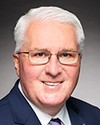Mr. Speaker, I will be sharing my time today with the member for Kanata—Carleton.
I rise this afternoon to speak about the brave members of the Canadian Armed Forces and their civilian colleagues on the ground in Kabul who helped coordinate the daring evacuation from Afghanistan this past summer.
I want to speak about this whole-of-government mission and how we worked closely with our allies and partners to bring as many Canadian citizens, permanent residents and Afghans to safety as possible.
First, let me say how grateful I am for the brave men and women of our Canadian Armed Forces. This event was certainly one of the most difficult non-combative evacuation operations ever undertaken by Canadian Armed Forces, and their members stepped up when the world needed them to.
All of us gathered here today have seen the harrowing images of thousands desperate to leave, with a limited number of spaces to get people out, and the CAF members doing their best to evacuate panicked civilians as the security situation disintegrated rapidly around them.
We know that prior to the rapid fall of Kabul to Taliban forces, Global Affairs and IRCC were working around the clock to get Canadian citizens and those vulnerable Afghans who were approved for resettlement in Canada onto flight manifests and out of the country as fast as possible.
With the Taliban now in charge, this was no longer a straightforward process. What used to be a short drive to the airport now took about 12 hours. Streets were clogged. With the security situation getting increasingly dangerous, chaotic and desperate by the hour, Global Affairs and IRCC issued a general call for all eligible evacuees rather than a staggered approach. This was done to ensure that the greatest number of people possible made it onto flights.
At this point, the single-biggest challenge to the evacuation effort was getting people to the airport through all the congestion, the Taliban checkpoints and the sporadic violence. For those who made it to the airport gates, they faced intense crowding, violence, sweltering heat and the reality there was no guarantee one could actually get inside. For those who managed to make it inside, the desperate situation caused fights to break out. We heard about families getting separated from each other in the chaos.
When Canadian Armed Forces evacuation aircraft arrived, they could only be on the ground for a very short window to keep the U.S.-led coalition air bridge functional. Despite all these significant challenges, CAF members still safely escorted large numbers of Canadians, permanent residents, allied citizens and vulnerable Afghans through the Kabul airport.
In total, Canada successfully evacuated approximately 3,700 people. All of us here are extremely proud of the Canadian Armed Forces members who worked under such incredibly dangerous conditions, with support from staff at Global Affairs and IRCC. We thank them again for their courage and compassion in the face of great danger to their own lives.
A lot of this coordination work was carried out from the Canadian embassy in Kabul. I want to recognize Global Affairs staff members for their essential work securing the facility and preparing for evacuation. We began developing our evacuation contingency plans in the spring of 2021. Next, the CAF deployed a strategic advisory team to design plans for a rapid evacuation and possible mission closure if the security situation were to deteriorate.
DND and the CAF had been working closely in support of government and Canadian partners for months as we carefully watched deployments on the ground, and it was those early discussions with our partners at Global Affairs that allowed us to plan well ahead of time for a number of different scenarios, including the potential extraction of personnel from the country by the Canadian Armed Forces personnel.
On July 23, the Government of Canada announced a program to resettle Afghans who had supported Canada's security and development efforts in Afghanistan. Defence team officials worked closely with Global Affairs and IRCC to explore how military personnel and assets could help support this important resettlement program.
By July 30, the government approved a request for assistance that began direct CAF involvement in evacuating Canadian citizens and permanent residents from the country as well Afghan nationals eligible for settlement under IRCC's special immigration measures program.
The first CAF and civilian chartered flights operated by the Government of Canada began transporting evacuees out of Afghanistan by August 4. On August 15, Global Affairs decided to temporarily suspend operations at our embassy in Kabul and all personnel were evacuated. By August 26, the end of the evacuation mission, the CAF had transported approximately 3,700 persons from Kabul in very difficult conditions.
In the aftermath, our departments have continued to do everything they can to support the resettlement of at-risk Afghans. The defence team is working to identify more interpreters who supported the Canadian mission and helped IRCC bring them over. We are also confirming employment records as part of the resettlement efforts.
We supported NATO's Operation Allied Solace and its mission to airlift over 1,000 Afghan contractors and immediate family members from Kuwait and Qatar to temporary camps in Kosovo in Poland. As part of this support, the CAF deployed three members to Kosovo, themselves originally from Afghanistan, to serve as interpreters at the camp.
At NATO's request, Canada had agreed to resettle up to 472 Afghan contractors subject to screening protocol. This is the highest commitment among our NATO allies and it is a commitment we gladly undertake. This pledge is part of our broader commitment to resettle 40,000 Afghans.
In the midst of the chaos in Kabul this summer, there were poignant reminders about why Canadians were there doing our best in a nearly impossible situation. There was an Afghan girl at the airport who was awestruck at the sight of a woman military police officer as she boarded one of our evacuation flights. She asked her dad, “How can a woman be a police officer?” Her father explained that in Canada women could be police officers. Looking up at the soldier, the little girl said that she wanted to be a police officer when she grew up.
There was also a little Afghan boy at the airport who was so greatly admired by one of our Canadian soldiers that he would not leave his side as the soldier carried out his work during an evacuation flight. We heard how the soldier cared for that boy who was about the same age as his own son, who was waiting for him to return safely home to Canada.
These are but two of what will eventually be thousands of personal stories of Afghan evacuees beginning a new life in Canada. On behalf of the Government of Canada, we welcome them to their new home. For members of the Canadian Armed Forces and all civilians who supported the evacuation effort, Canadians thank them for a job well done.












